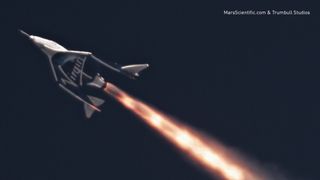Virgin Galactic Completes 1st Powered Test Flight Since Fatal 2014 Crash
MOJAVE, Calif. — Virgin Galactic made a triumphant return to powered flight today (April 5) with a successful test of the company's SpaceShipTwo VSS Unity suborbital vehicle. It was the company's first powered flight in nearly 3.5 years, following the tragic loss of SpaceShipTwo VSS Enterprise on Oct 31, 2014.
VSS Unity was dropped from its WhiteKnightTwo mothership from about 50,000 feet (15,000 meters) over the mountains about 20 miles (32 kilometers) north of the Mojave Air and Space Port in California. Pilots David Mackay and Mark "Forger" Stucky fired Unity's hybrid engine for 30 seconds, boosting the vehicle to a top speed of Mach 1.87 and a maximum altitude of 84,271 feet (25,686 m) before gliding back to the runway at the spaceport, Virgin Galactic representatives said.
During the descent, the crew deployed SpaceShipTwo's feather system, which reconfigures the ship into a high-drag shuttlecock by moving its twin tail booms. The feather will be used to soften the vehicle's re-entry into the Earth's atmosphere during spaceflight. [Virgin Galactic's SpaceShipTwo VSS Unity Spaceliner in Pictures]
"@virgingalactic back on track,ꞌꞌ Virgin Galactic founder Richard Branson tweeted after today's test. "Successful powered flight, Mach 1.6. Data review to come, then on to the next flight. Space feels tantalizingly close now."

Unity's first powered flight came after more than a year of unpowered tests that saw the spacecraft glide back to the runway seven times. The most recent glide flight was on Jan. 11.
Virgin Galactic representatives have said they will conduct a series of powered flights throughout 2018 with increasingly longer engine firings. They expect the spaceship to get at least 50 miles (80 km) up later this year, the altitude defined as the beginning of space by a number of entities, including the U.S. Air Force.
Eventually, the test program will move down to Spaceport America in New Mexico, where Virgin Galactic is the anchor tenant.
Get the Space.com Newsletter
Breaking space news, the latest updates on rocket launches, skywatching events and more!

The company hopes to start commercial service from Spaceport America later this year. Branson plans to be on that first commercial flight of Unity, which seats six passengers and two pilots. Other SpaceShipTwo vehicles are under construction.
Today's flight was the 12th overall for Unity, a total that includes four captive-carry tests. It was the 246th flight of the WhiteKnightTwo mothership, VMS Eve. Enterprise had successfully completed 30 glide flights and three powered tests before it was lost.
Today's flight was a major milestone in another important way. While Enterprise was built and flight-tested by the company Scaled Composites, Unity was produced by The Spaceship Co., which is also owned by the Virgin Group.

"Itꞌs official: @TheSpaceshipCo is now the manufacturer of a crewed, supersonic vehicle. A privately built and operated one, at that. That is 'very' rare company to keep," tweeted William Pomerantz, a former vice president at Virgin Galactic who has moved over to Virgin Orbit.
"THAT WAS AWESOME!" Virgin Galactic President George Whitesides wrote on Twitter. "Congrats to the pilots, crew, ground crew and all the people who designed and built that beautiful ship. Look forward to doing it again!"
The first successful powered flight was a relief to Virgin Galactic after the loss of Enterprise on Halloween 2014. That vehicle broke up near Koehn Lake, resulting in the death of Scaled Composites co-pilot Mike Alsbury. Pilot Pete Siebold parachuted to safety with serious injuries.
The U.S. National Transportation Safety Board found that a design error allowed Alsbury to unlock the feather device prematurely during the powered ascent. The co-pilot was supposed to unlock the feather when the ship hit Mach 1.4; instead, he unlocked it as the vehicle was approaching Mach 1. Aerodynamic forces reconfigured the ship while the engine was still burning, resulting in the breakup.
The reason the pilots have to unlock the feather during powered ascent is to make sure the locks don't stick. If they do, then the pilots would need to abort the flight and glide back to the runway. SpaceShipTwo could suffer serious damage if it descended from high altitude and could not deploy the feather system.
Following the loss of Enterprise, engineers modified the feather system to prevent the pilots from releasing the locks prematurely.
Follow us @Spacedotcom, Facebook or Google+. Originally published on Space.com.
Join our Space Forums to keep talking space on the latest missions, night sky and more! And if you have a news tip, correction or comment, let us know at: community@space.com.
Douglas Messier is the managing editor of Parabolicarc.com, a daily online blog founded in 2007 that covers space tourism, space commercialization, human spaceflight and planetary exploration. Douglas earned a journalism degree from Rider University in New Jersey as well as a certificate in interdisciplinary space studies from the International Space University. He also earned a master's degree in science, technology and public policy from George Washington University in Washington, D.C. You can follow Douglas's latest project on Twitter and Parabolicarc.com.
